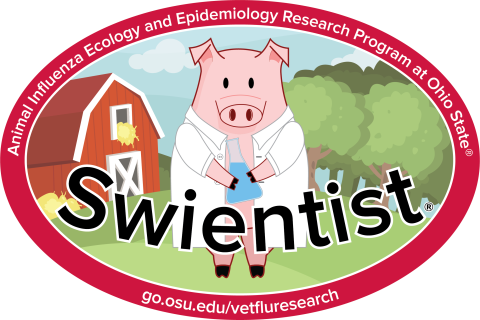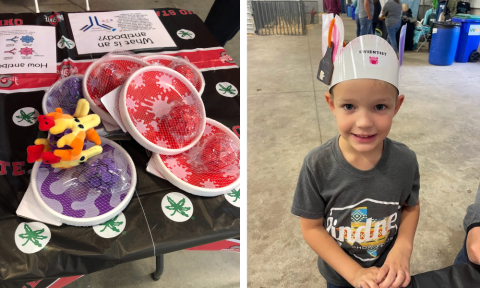Swientist® program empowers young farmers

Article by: Lisa Lopez Snyder
Originally Published
Hands-on learning curbs viral spread
It’s no exaggeration to say that thousands of young people in agriculture across Ohio and nationally are “swientists.” This is thanks to The Ohio State University College of Veterinary Medicine investigators, whose Swientist® outreach program works to identify swine flu and other zoonotic diseases in humans and to prevent their spread.
The Swientist® program was established in 2015 in response to a significant increase in swine flu infections among people attending county fairs in 2011-2012, says Jacqueline Nolting, MS, PhD, swine health and biosecurity extension specialist and assistant professor of veterinary preventive medicine at Ohio State.
Nolting has been actively collecting samples since 2009, collaborating with Andrew Bowman, MS, DVM, PhD, DACVPM, an associate professor of veterinary preventive medicine at Ohio State and their agriculture partners. “Most of those individuals were kids showing the pigs,” she says.
Today, Nolting also attends livestock exhibitions, mostly swine shows, to show 4-H and National FFA members how to reduce the risk of influenza A virus and other zoonotic diseases.

Partnerships make it possible
Funded by the Council of State and Territorial Epidemiologists (CSTE), the Swientist® program embraces a “test, test and thrive” approach. The team conducts swabs on exhibition pigs, tests the results, and offers fun, educational programs to young exhibitors, teaching them best practices for keeping themselves and their animals healthy.
Nolting partners regularly with Ohio Pork Council’s Kelly Morgan, who coordinated all 24 Ohio Pork Council’s OHPig Jackpot shows in 2023. They work closely with Ohio State’s Extension and the 4-H Animal Sciences Program.
Together with Nolting and Bowman, the team conducts testing and engages young exhibitors in hands-on learning activities, from demonstrations on measures to minimize viral transmissions and guidance on proper handwashing to word game challenges designed to test their knowledge of influenza.
OH-Pigs participants receive a backpack with seven biosecurity activities, including a “skill-a-thon” component catering to various age groups, where the youngest participants gain insights into farm equipment used in pig breeding. At the same time, older kids delve into topics like meat science and explore key issues within the swine industry.
They also partake in a biosecurity poster contest where posters are hung in the swine barn at the Ohio State Fair and have a chance at winning an iPad. They can also take selfies that showcase their commitment to using biosecurity practices at home.
“We have taken steps to enhance the educational experience by including informative materials within the exhibition registration bags,” Nolting says. “We’re there every day of the exhibition, offering something different each day to actively engage attendees and promote a deeper understanding of swine health and biosecurity.”
Morgan, an educator at Columbus Public Schools, says the kids love it when Bowman encourages them to ‘find the dirtiest place in the barn and swab it.’
“Andy and Jacqueline have a gel that can be read under a black light, which vividly illustrates the extent of the germ spread,” she explains. “The kids were genuinely amazed by the number of germs on the swab,” Morgan says. “And we know pigs’ noses are in everything.”
Program’s impact has a ripple effect
The results have been significant, say Morgan and Nolting. “Biosecurity is something that kids know about now; they’re cleaning and disinfecting, which are practices we talk about,” Nolting says. “They have become aware of zoonotic diseases and are learning to identify the clinical signs of illness in their pigs,” she adds. “We see this knowledge reaching their parents, educating them about healthy practices and recognizing these signs of illness in their pigs, creating a positive ripple effect.”

Nolting estimates the team has reached thousands of young exhibitors, as the National Junior Swine Association alone has 1,300 members, which doesn’t include all the exhibitors at the state fairs nationwide.
“We have a team that stays connected with its 'swientists' through regular social media posts and a quarterly newsletter.”
Morgan says her children, who are on the OH-PIGS Circuit and have been in the Swientist® program since ages nine and 10, instruct other kids about biosecurity. “They’ll tell their friends, ‘Those shoes don’t belong on my trailer,’ or ‘If you come to my house, can you bring other shoes’?
Extending education
Today, Nolting notes, the Swientist® program has expanded its scope to explore how the virus is changing and shifting from a primary focus on ‘youth in agriculture’ to addressing zoonotic disease in various farm animals, such as chickens. Additionally, the program has adapted the Swientist® model to serve individuals showing poultry and those raising backyard poultry.
“The Swientist® program is a remarkable example of the innovative work our faculty are doing to educate the public on best practices that impact the interface of people, animals and the environment,” says Rustin Moore, DVM, PhD, DACVS, dean, Ohio State College of Veterinary Medicine. “Through these hands-on learning experiences, the program engages participants, reflecting how our veterinary students are taught in their DVM program. Real-world experiences for these young exhibitors and fairgoers are helping them connect the dots to their real-life situations.”
To expand the program’s educational outreach, Nolting developed a curriculum for women and minorities in STEM fields. Recently, she secured a grant from the U.S. Department of Agriculture to support the implementation of this curriculum. In addition, a newly developed online curriculum for high school agricultural educators, which she spearheaded, received approval from the national FFA after a successful pilot phase. This curriculum will now be accessible nationwide.
“Sometimes it’s harder for adults to be a catalyst for change, but children are eager to embrace learning and new challenges,” she says. “We frequently hear in conversations that children influence their parents by saying, ‘We must do this or that,’ and parents readily go along with these changes to support their child’s educational journey.”
The effort of the Swientist® program to positively impact the health of animals, people, and the ecosystem exemplifies our ambition to Be The Model®, directly impacting the future of biosecurity and veterinary medicine.
Learn more about the Swientist® program